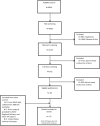Global Estimates of the Prevalence and Incidence of Four Curable Sexually Transmitted Infections in 2012 Based on Systematic Review and Global Reporting
- PMID: 26646541
- PMCID: PMC4672879
- DOI: 10.1371/journal.pone.0143304
Global Estimates of the Prevalence and Incidence of Four Curable Sexually Transmitted Infections in 2012 Based on Systematic Review and Global Reporting
Abstract
Background: Quantifying sexually transmitted infection (STI) prevalence and incidence is important for planning interventions and advocating for resources. The World Health Organization (WHO) periodically estimates global and regional prevalence and incidence of four curable STIs: chlamydia, gonorrhoea, trichomoniasis and syphilis.
Methods and findings: WHO's 2012 estimates were based upon literature reviews of prevalence data from 2005 through 2012 among general populations for genitourinary infection with chlamydia, gonorrhoea, and trichomoniasis, and nationally reported data on syphilis seroprevalence among antenatal care attendees. Data were standardized for laboratory test type, geography, age, and high risk subpopulations, and combined using a Bayesian meta-analytic approach. Regional incidence estimates were generated from prevalence estimates by adjusting for average duration of infection. In 2012, among women aged 15-49 years, the estimated global prevalence of chlamydia was 4.2% (95% uncertainty interval (UI): 3.7-4.7%), gonorrhoea 0.8% (0.6-1.0%), trichomoniasis 5.0% (4.0-6.4%), and syphilis 0.5% (0.4-0.6%); among men, estimated chlamydia prevalence was 2.7% (2.0-3.6%), gonorrhoea 0.6% (0.4-0.9%), trichomoniasis 0.6% (0.4-0.8%), and syphilis 0.48% (0.3-0.7%). These figures correspond to an estimated 131 million new cases of chlamydia (100-166 million), 78 million of gonorrhoea (53-110 million), 143 million of trichomoniasis (98-202 million), and 6 million of syphilis (4-8 million). Prevalence and incidence estimates varied by region and sex.
Conclusions: Estimates of the global prevalence and incidence of chlamydia, gonorrhoea, trichomoniasis, and syphilis in adult women and men remain high, with nearly one million new infections with curable STI each day. The estimates highlight the urgent need for the public health community to ensure that well-recognized effective interventions for STI prevention, screening, diagnosis, and treatment are made more widely available. Improved estimation methods are needed to allow use of more varied data and generation of estimates at the national level.
Conflict of interest statement
Figures



References
-
- Global Burden of Disease Study 2013 Collaborators. Global, regional, and national incidence, prevalence, and years lived with disability for 301 acute and chronic diseases and injuries in 188 countries, 1990–2013: a systematic analysis for the Global Burden of Disease Study 2013. Lancet. 2015. 10.1016/S0140-6736(15)60692-4 - DOI - PMC - PubMed
-
- Holmes K. Sexually transmitted diseases. 4th ed New York: McGraw Hill; 2008.
-
- Amin A, Garcia Moreno C. Addressing gender-based violence to reduce risk of STI and HIV. Sex Transm Infect. 2013;89:A8.
-
- Gerbase A, Rowley J, Heymann D, Berkley S, Piot P. Global prevalence and incidence of selected curable STDs. Sex Transm Infect. 1998;74(Suppl 1)S12–S16. - PubMed
-
- World Health Organization; Global prevalence and incidence of selected curable sexually transmitted infections: overview and estimates. Geneva, 2001. Available at: http://www.who.int/hiv/pub/sti/who_hiv_aids_2001.02.pdf - PubMed
Publication types
MeSH terms
LinkOut - more resources
Full Text Sources
Other Literature Sources
Medical

